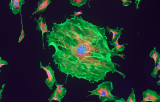
MAF probe for ISH CE/IVD - Multiple Myeloma (MM)
MM is a malignant post-germinal center tumor of somatically-mutated, isotype-switched plasma cells that accumulate in the bone marrow. It is often preceded by a premalignant state known as monoclonal gammopathy of undetermined significance (MGUS). Five recurrent primary translocations involving the immunoglobulin heavy locus (IGH) have been identified in 40% of MGUS and MM tumors. They include t(11;14)(q13.3;q32.3), t(6;14) (p21.1;q32.3), t(4;14)(p16.3;q32.3), t(14;16)(q32.3;q23), and t(14;20) (q32.3;q12), which involve the genes CCND1, CCND3, FGFR3 and NSD2, MAF, and MAFB, respectively. All of these translocations lead to the dysregulation and overexpression of the target genes as a consequence of their juxtaposition to regulatory sequences of the IGH locus. t(14;16) occurs in approximately 5% of MM patients and is associated with a more aggressive clinical outcome. The 16q23 breakpoints have been found to be scattered 550-1280 kb centromerically to the MAF gene within the WWOX gene. Hence, detection of t(14;16) by FISH represents a useful prognostic tool and may aid in therapeutic decision making in MM.
Resultados de su búsqueda : 0 Producto encontrado
Refine su búsqueda :
RUOCE / IVD
Referencia
Descripción
Cond.
Precio Sin IVA
‹
›


